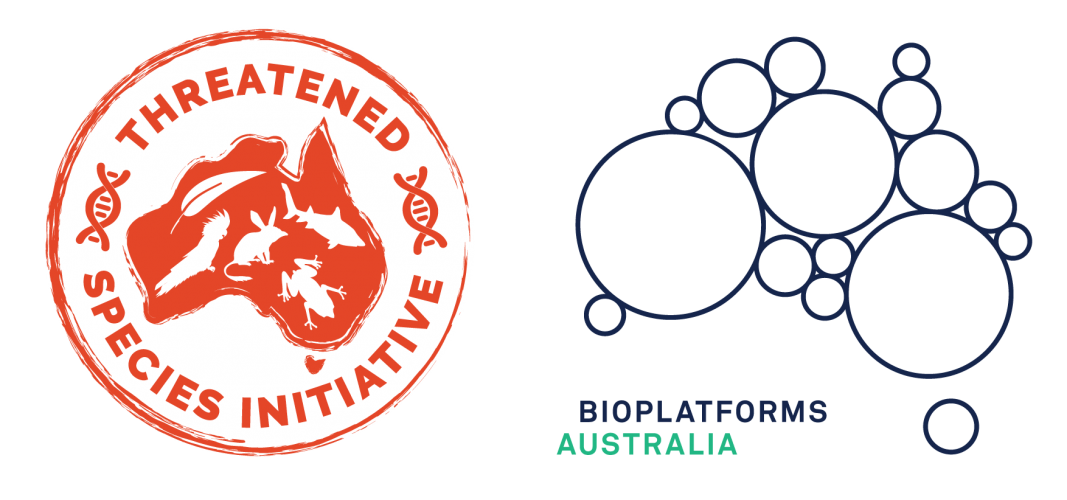Pilot Project
The Threatened Species Initiative (TSI) brings together genome biologists, population biologists, bioinformaticians, population geneticists and zoologists with conservation agencies across Australia, including government, zoos and NGOs. Our objective is to create a foundation of genomic data to advance our understanding of key threatened species in Australia, ultimately empowering conservation practitioners to leverage genomic information to tackle critical biological and conservation issues – including genetic data to inform translocations, captive breeding and their ongoing management.
This initiative, which will run over the coming 3-years, has been developed in direct consultation with government threatened species managers and non-government conservation organisations, to ensure that the project meets their needs and develops a systematic approach to integrating genomics into species recovery.
Building on existing Bioplatforms Australia investment into Oz Mammal Genomes, Genetics of Australian Plants and the Australian Reptile and Amphibian Genome Project, the TSI will:
- develop best practice reference genomes for up to 50 key threatened species in Australia, alongside reduced representation sequencing datasets for individuals of each species;
- generate analytical methods for routine adoption of genetic analysis for threatened species management plans;
- develop a reporting mechanism on genetic appropriateness of breeding populations for use in species translocations and subsequent management actions;
- develop tools for ongoing genetic monitoring e.g. genetic diversity over time, response to intervention etc.
- ensure that genomic data is made freely available to enable iterative and ongoing analysis into the future.
Outcomes from this program will be made available through open access platforms and details on protocols and methods will be available online through the Threatened Species Initiative website (coming shortly).
To read more about the initiative please see: https://bioplatforms.com/projects/threatened-species/
THE PILOT PHASE
To ensure seamless delivery of the larger project, the TSI is running a Pilot to trial, test and bed down workflows and pipelines to ensure outputs are fit-for-purpose for conservation management and decision-making.
The TSI Steering Committee has undertaken a
review of the list of species provided from the consultation with the
threatened species managers; existing Bioplatforms Australia framework
initiatives; and the recent Commonwealth government bushfire list of priority
species.
Pilot phase scenarios
The species on these lists were grouped into the following five scenarios to enable comprehensive testing at different stages of the conservation genomics pipeline:
- The species has no reference genome, no population genetic data
- The species has closely related species with a reference genome, but no population genetic data
- The species has a reference genome, or conspecific genome, some population genetic data and is subject to conservation action which mixes genetically distinct populations
- The species has no reference genome, but population genetic data exists
- The species has no reference genome, but short-read data exists, and some population genetic data exists
Pilot phase criteria
Species were then assessed against the following criteria to ensure we maximise effort and resources whilst minimising duplications:
- The species has existing data, including information produced by other Bioplatforms Australia initiatives, or genomic work proposed or already being undertaken, for the species, or a closely related species;
- The species has genetic research listed as a priority 1 action in its National (or State) Recovery or other conservation Plan;
- The species is listed on the Commonwealth government’s bushfire priority list of species requiring urgent management intervention;
- The species is involved in a current or upcoming conservation translocation program (including insurance populations) and no or limited genetic data exists;
- There are samples readily available for the species;
- Co-investment for the species exists, or there is potential for co-investment, in generating data for the species; and
- Together, the pilot species represent different conservation activities across Australia.
The resulting seven species that have been nominated for the pilot project are detailed below:
| Scenario | Species | Lead end-user group | Genetics group lead |
| 1. The species has no reference genome, no population genetic data | Eastern bristlebird (Dasyornis brachypterus) | Victoria DEWLP NSW Saving Our Species | Andrew Weeks, University of Melbourne |
|
Native guava (Rhodomyrtus psidiodes) | NSW Saving Our Species | Maurizio Rossetto, Royal Botanical Gardens Sydney | |
| Swan Galaxiid (Galaxias fontanus) | Inland Fisheries Service Tasmania | Bruce Deagle, CSIRO Australian National Fish Collection | |
| 2. The species has closely related species with a reference genome, but no population genetic data | Hastings River mouse (Pseudomys oralis) | NSW Saving Our Species QLD Department of Environment & Science | Kevin Rowe, Museums Victoria |
| 3. The species has a reference genome, or conspecific genome, some population genetic data and is subject to conservation action which mixes genetically distinct populations | Barred bandicoots (Perameles bougainville & P. gunnii) | WA Department of Biodiversity, Conservation and Attractions Department of Environment, Land, Water and Planning Victoria | Kate Farquharson, University of Sydney (P. bouganiville) Andrew Weeks, University of Melbourne (P. gunnii) |
| 4. The species has no reference genome, but population genetic data exists | Orange-bellied parrot (Neophema chrysogaster) | OBP National Recovery Team | Carolyn Hogg, University of Sydney |
| 5. The species has no reference genome, but short-read data exists, and some population genetic data exists | Ghost bat (Macroderma gigas) | WA Department of Biodiversity, Conservation and Attractions QLD Department of Environment and Science NT Department of Environment and Natural Resources | Kym Ottewell, WA Department of Biodiversity, Conservation and Attractions |
With the lessons learnt from the pilot phase, and following consultation to identify a further set of priority species, the TSI will have an open program where we will engage with relevant conservation management groups to guide this process.
We welcome collaboration and parties interested in participating in the pilot phase are encouraged to get in contact with Sarah Richmond (srichmond@bioplatforms.com). We look forward to providing the Australian genomics and conservation communities with further details as the pilot project progresses.
